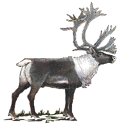|
The
Woodland Caribou
[Rangifer tarandus-caribou]
 My
educational journey on the Woodland Caribou brought several realizations: My
educational journey on the Woodland Caribou brought several realizations:
 The Woodland Caribou living in the western provinces and Ontario are different
than the large Northern herds of Caribou [Rangifer tarandus-pearyi, -groenlandicus,
-granti, -eogroenlandicus] found in Alaska and the Territories.
The Woodland Caribou living in the western provinces and Ontario are different
than the large Northern herds of Caribou [Rangifer tarandus-pearyi, -groenlandicus,
-granti, -eogroenlandicus] found in Alaska and the Territories.
 Woodland Caribou stay in small groups and don't migrate over large distances as
do their Northern Cousins. In Alberta they're found in the mountain parks [Banff,
Jasper, Willmore] and in the forested foothills and eastern slopes regions.
Woodland Caribou stay in small groups and don't migrate over large distances as
do their Northern Cousins. In Alberta they're found in the mountain parks [Banff,
Jasper, Willmore] and in the forested foothills and eastern slopes regions.
 People in Alberta, British Columbia, Saskatchewan, Manitoba and Ontario are unaware
that we are in danger of losing the Woodland Caribou -- perhaps because of the
media focus on the big northern herds. Seems like there are lots of Caribou in
the North ... so what's the problem?
People in Alberta, British Columbia, Saskatchewan, Manitoba and Ontario are unaware
that we are in danger of losing the Woodland Caribou -- perhaps because of the
media focus on the big northern herds. Seems like there are lots of Caribou in
the North ... so what's the problem?
 Given that the Woodland Caribou and other caribou species are on a journey to
extinction [ref
World Wildlife Fund] it's strange that a web search using "Caribou"
mostly turns up WEB pages that are about hunting them, recipes for cooking them,
or selling products named after them -- and NOT on understanding and protecting
them. Try the search engines yourself to see what I mean.
Given that the Woodland Caribou and other caribou species are on a journey to
extinction [ref
World Wildlife Fund] it's strange that a web search using "Caribou"
mostly turns up WEB pages that are about hunting them, recipes for cooking them,
or selling products named after them -- and NOT on understanding and protecting
them. Try the search engines yourself to see what I mean.
 I am not suggesting that hunting is the problem. In fact, hunting of the woodland
caribou is no longer permitted. The key problems are that the specific habitats
of the Woodland Caribou, the boreal forest, the foothills and the mountain montane
regions, are being overdeveloped without regard for the survival of this unique
species. And, there's illegal hunting - called poaching - a practice that is enabled
by the many access roads developed for oil and gas and forestry operations and
by inadequate resources provided by our governments for wildlife protection programs.
I am not suggesting that hunting is the problem. In fact, hunting of the woodland
caribou is no longer permitted. The key problems are that the specific habitats
of the Woodland Caribou, the boreal forest, the foothills and the mountain montane
regions, are being overdeveloped without regard for the survival of this unique
species. And, there's illegal hunting - called poaching - a practice that is enabled
by the many access roads developed for oil and gas and forestry operations and
by inadequate resources provided by our governments for wildlife protection programs.
 As you will see in the links pages below, there is hope for the Woodland Caribou.
In some regions attempts are underway to ensure the survival of the Woodland Caribou
by protecting and enhancing its habitat.
As you will see in the links pages below, there is hope for the Woodland Caribou.
In some regions attempts are underway to ensure the survival of the Woodland Caribou
by protecting and enhancing its habitat.
 Still, my conclusion is that the Governments of Western Canada are not doing enough
to prevent the extinction of the Woodland Caribou.
Still, my conclusion is that the Governments of Western Canada are not doing enough
to prevent the extinction of the Woodland Caribou.
 Of course, you must decide for yourself. The links below will provide you with
a fairly complete picture of the status of the Woodland Caribou in Canada and
of the other Northern Subspecies on the Continent.
Of course, you must decide for yourself. The links below will provide you with
a fairly complete picture of the status of the Woodland Caribou in Canada and
of the other Northern Subspecies on the Continent.
Webmaster
|
Alberta's
Woodland Caribou
 Status:
In 1985 woodland caribou were added to Alberta's endangered wildlife list. Their
numbers have been declining since early this century. Today, fewer than 7,000
remain, sparsely distributed over northern and west-central Alberta. Status:
In 1985 woodland caribou were added to Alberta's endangered wildlife list. Their
numbers have been declining since early this century. Today, fewer than 7,000
remain, sparsely distributed over northern and west-central Alberta.
Habitat: Most remain
in forested habitats year-round. The mountain population of caribou migrates 80
km or more between their forested foothills winter range and alpine summer range. Size: Adult bulls
weigh up to 270 kg but average about 180 kg. Cows average 115 kg. Both males and
females grow antlers but cows' are shorter and have fewer points. Food: Caribou's
major food sources are ground and tree lichens. It takes 80 to 150 years for a
forest to grow enough lichens for caribou. They also eat shrubs, grasses and willows. Breeding: Caribou
mate in early to mid-October. Calves are born by early June. A cow doesn't mate
or breed until she's two-and-a-half and will usually have one calf per year. Risk factors: Logging,
coal mining and oil and gas exploration have greatly reduced the woodland caribou's
habitat. When large areas of old-growth coniferous forests are logged, moose,
deer and elk populations increase. As their prey become more plentiful, more wolves
move in. Caribou are most vulnerable to wolves so they suffer the greatest losses. This increased predation,
triggered by resource exploitation that fails to take Caribou needs into account,
along with overhunting -- legal and illegal -- are the main reasons for the decline
of woodland caribou in their southern range. Management: Alberta
Environmental Protection's wildlife management branch has enlisted the help of
the oil, gas and forestry industries to protect caribou habitat. The branch also
hopes to reduce wolf predation and illegal hunting. Many caribou have been fitted
with radio collars to aid biologists with data collection. Hunting: It is illegal
to kill or disturb caribou at any time in Alberta. Source: Alberta
Environmental Protection, Fish & Wildlife Branch.
Want to help? Without
our help, the Woodland Caribou will be gone from Alberta in our lifetime! Join
or Make a Donation to an Organization that makes a Difference.
 The Alberta Wilderness Association
The Alberta Wilderness Association
 Canadian Parks and Wilderness Society
Canadian Parks and Wilderness Society
 The Federation of Alberta Naturalists
The Federation of Alberta Naturalists
 World Wildlife Fund - Canada
World Wildlife Fund - Canada
 Canadian Nature Federation
Canadian Nature Federation
 Canadian Wildlife Federation
Canadian Wildlife Federation
 US & Canadians Organizations
US & Canadians Organizations
|